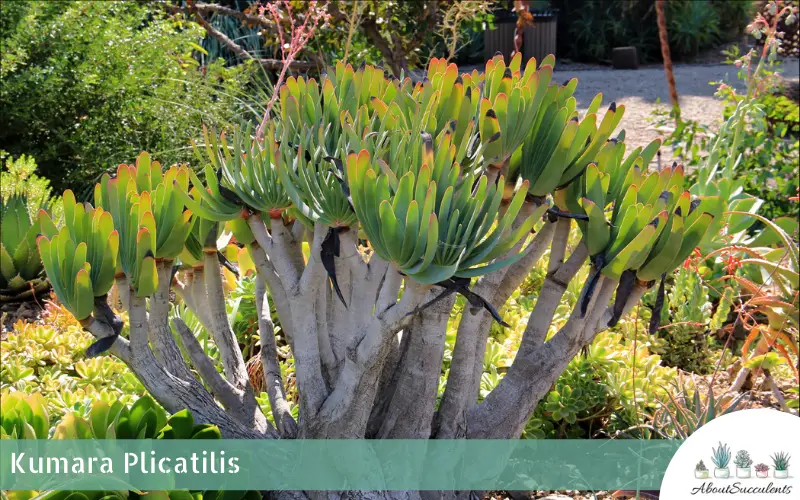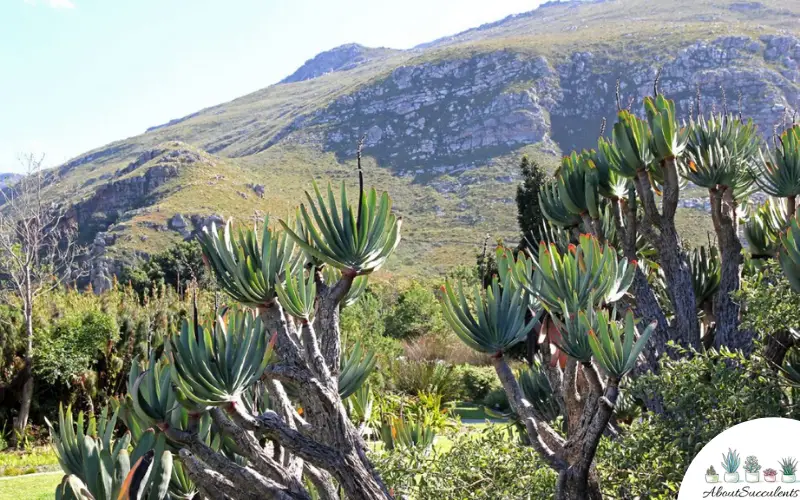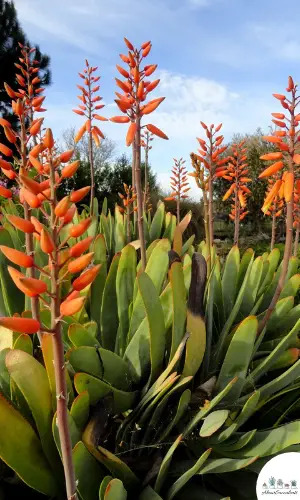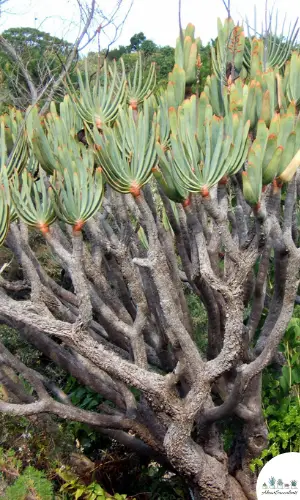
Kumara plicatilis is a succulent with an unusual but striking appearance that contributes to its uncommon beauty. Kumara plicatilis used to be called Aloe plicatilis and is referred to by other names such as Fan Aloe, Book Leaf Aloe, and French Hoek Aloe.
Fan Aloe’s predominant feature is the extraordinary arrangement of its leaf-heads which look like neatly arranged pairs of fans. The leaf-heads sit on forked branches which are borne on a grey trunk.
The oblong-shaped leaves of Kumara plicatilis measure 7 to 11-inches long (20 to 30cm) and 1.5-inches (4cm) wide, have a sea-green color, oftentimes dotted with white spots, and grow upwards.
Viewed from a distance, the leaf-heads look like massive hands that are imploring the heavens.
Kumara plicatilis is often described as “bonsai” in appearance and can grow to a height of 8-feet (2.4m) with a width of 6-feet (1.8m). It belongs to the Aloaceae family and is native to South Africa.
General Information:
Also known as: Fan Aloe, Book Leaf Aloe, and French Hoek Aloe
Plant Family: Aloaceae
Origin: South Africa
Height: 7 to 11-inches long (20 to 30cm)
Exposure: Direct exposure to sunlight up to 6 hours
Water Needs: Frequent during the summer months; very little to no watering in the winter or cold season.
Soil Type: Cactus or a potting soil mix composed of 2 parts peat moss, 1 part clean sand, and 1 part perlite.
Soil pH: Acidic (5.5 to 6.5 pH)
How to Grow and Care for Kumara Plicatilis

Kumara plicatilis is easily grown in gravelly or sandy, well-drained soil. Fan Aloe is highly-tolerant to drought but not the cold season.
Fan Aloe prefers warmer temperatures at 21°C to 27°C (68°F to 81°F) but they can survive a drop until 4.5°C (40°F). It should be grown in a container that can be brought indoors during the cold winter months.
Sunlight
Kumara plicatilis grows better under direct sunlight. Fan Aloe should be located in an area in the garden that receives 6 hours of sunlight every day. If the succulent is brought indoors, it is recommended to place it under a grow light.
Fan Aloe can also tolerate time under a mild shade. If you have been growing your plant from a shaded area, wait for it to harden before you transfer the succulent to an area with direct sunlight or it will get scorched.
Watering

Kumara plicatilis is very resilient to drought but the plant will thrive and produce many beautiful flowers when watered correctly. As with most succulents, it is best to give Aloe Fan water when its soil feels dry to the touch.
In the winter season, soil retains moisture longer. During the cold months, pare down the watering schedule of Fan Aloe. It the succulent receives too much water, especially in the winter, the roots will rot and infect the rest of the plant.
Pot and Soil
It is important to place Kumara plicatilis in a container that has good drainage. Repot Fan Aloe if the succulent has grown to a point that it has tipped over the pot.
Fill up the pot with well-draining soil such as cactus or a potting soil mix composed of 2 parts peat moss, 1 part clean sand, and 1 part perlite.
These ingredients will improve soil drainage and the level of air circulation between the roots. The recommended pH level of the soil for Kumara plicatilis is 5.5 to 6.5.
How to Propagate Kumara Plicatilis
Kumara plicatilis can be propagated by using 3 methods: Stem or branch Cuttings, seeds, and re-potting the root ball of the plant.
Fan aloe is a slow-growing plant. If you use the seed method, it will take a long time to see the fruits of your labor. The cuttings and re-potting methods will deliver faster results.
1. Cuttings Method
Step 1: Remove a stem or branch from the plant by using a sharpened and sterilized knife or garden shears.
Step 2: Allow the cuttings to dry out under a shaded area for a few days. The cuttings are ready for planting once it has hardened or developed calluses.
Step 3: Insert the cut end of the stem or branch into the soil. Make sure to leave enough space between the cuttings.
Step 4: Water the soil whenever it has dried out completely.

2. Seed Method
Step 1: Make sure the pot where you will plant the seeds of Kumara plicatilis is filled with well-draining soil and allows for proper air circulation. Cactus soil and river sand are good soil choices for growing Fan Aloe from seed.
Step 2: Plant seeds into potting soil and place the pot in an area that receives direct sunlight. If the Fan Aloe will be propagated indoors, place the pot under a grow light.
Step 3: Provide seedlings water when the soil is dry to the touch.
3. Re-Potting the Root Ball
Step 1: When Kumara plicatilis tips over its pot, the fall could expose a compact mass of roots that are located under the stem of the plant. This is called the root ball.
Step 2: Divide or cut the root ball with a sterilized and sharpened knife.
Step 3: Plant the root ball in the new larger pot.Step 4: Give the soil water when it has completely dried out.
Frequently Asked Questions
Is Kumara Plicatilis Toxic for Cats and Dogs?
Kumara plicatilis does not appear in the list of toxic plants for cats and dogs on the website of the American Society for the Prevention of Cruelty to Animals (ASPCA).
Why is my Kumara Plicatilis Dying?
There are 2 possible causes why your Kumara plicatilis succulent is dying: Overwatering and pest infestation.
1. Overwatering
Fan Aloe is highly-resistant to drought and can thrive with weekly watering in the summer and once-a-month watering schedule in the cold winter season.
Overwatering will cause the succulent’s roots to rot and lead to the development of fungal infection which can contaminate the entire plant.
In humid weather, Kumara plicatilis can develop rust which is a type of fungal disease. To prevent rust from developing, spray the plant with a fungicide that has a copper base.
2. Pest Infestation
Kumara plicatilis is a favorite target of aphids and snout beetles. To keep the beetles away, spray the succulent plant with a systemic insecticide. It is important that the insecticide gets into the growth points which are found between Fan Aloe’s leaves.
Does Kumara Plicatis Produce Flowers?
Kumara plicatilis produces flowers at different times of the year but frequently during the winter season.
The succulent’s flowers have a pendulous and cylindrical shape with an orange-red color. The flowers can measure 1.77 to 2.16-inches or 4.5cm to 5.5cm long.
Last Updated on June 12, 2022 by Sofia Lara